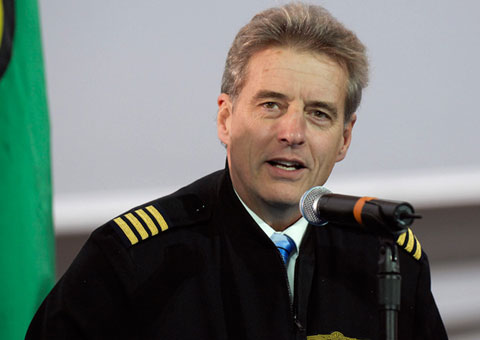
Boeing chief test pilot Mike Carriker.
While the commercial and general aviation communities face many unique challenges, a growing gap between supply and demand for pilots in years to come is a common concern. Boeing’s chief test pilot has added his voice to a call for training overhaul.
"In my 25-year flying career—spanning military and commercial aircraft—there has been little change in training. Yet aircraft and teaching technologies have evolved exponentially," said Mike Carriker, Boeing test and evaluation chief pilot for new airplane development. "We must make use of modern technology and focus our training efforts on equipping pilots and technicians with the knowledge to make the right decisions for the best, most efficient global transportation system."
Carriker, in remarks at the World Aviation Training Symposium in Orlando, Fla., in April, and in an email interview with AOPA that followed, recalled a recent type rating class in which students were tasked with flying ADF, NDB, VOR circle-to-land, and ILS—“all the standard approaches from yesteryear.” What about RNAV, Carriker wanted to know?
“Well, I was told that the organization who delivered the type course did not like the idea and does not allow that airline to use them. It was apparent that they were content with the 40-year-old status quo. This approach will not work with the younger generations that we’re trying to attract to our industry,” Carriker said. “I also advocate that the crews hand fly the optimized guidance provided. Keep your aviating skills constantly refreshed, you never know when you might need them.”
Recent history offers tragic examples that support this point.
Classroom instruction on classroom-based computers also fall short of delivering what’s needed to teach a new generation of students well accustomed to working with iPads and similar devices, and Carriker wants trainers to make better use of the various platforms now available. When it comes to the training itself, Carriker said, it’s time to move beyond rote memorization and focus on developing competency. For example, it’s not as important for a pilot to know how many loops and detectors are in a fire suppression system as it is for the pilot to know exactly what to do when the system activates.
“We want crews to understand systems, that pilot plus machine equals a system,” Carriker said. “We need airplane or system competency, the integrated system of pilot plus machine, rather than the ability to memorize snippets of manuals.”
Boeing, producer of some of the world’s most technologically advanced aircraft, predicts the industry will need to attract more than 1 million new pilots and technicians over the next 20 years to keep those aircraft flying.
While Carriker focuses much of his attention on new technology, stemming the loss of GA pilots – an important source of commercial aviators in the past and future – requires a focus on educational quality. AOPA’s research on the optimal flight training experience found that educational quality, consisting of a supportive and effective instructor with organized lessons, is key to helping student pilots achieve their goals. That’s according to AOPA Manager of Prospective Pilot & Youth Outreach Brittney Miculka, one of many staff at the association working to improve retention and reduce a flight training dropout rate that leaves as many as eight in 10 students without a certificate.
Modern simulators and electronic flight training are an important part of GA training, helping to ease the financial burden of earning a certificate. But AOPA research has clearly identified a more important element when it comes to GA training: relationships—chief among them the relationship between CFI and student, and making the right match. AOPA offers a variety of tips, tools, and other resources to help students find a program, and an instructor, best-suited to the student’s individual needs and goals.
A well-maintained fleet of high-quality aircraft, a focus on understanding the individual student’s goals and learning style, and offering entry to the various communities of aviators are the tools that GA flight schools must have to help solve what is shaping up to be an alarming shortage of pilots, Miculka said. Even as technology advances, pilot training at the grassroots level will remain an important source of flight instructors and airline pilots.
“Certainly, a GA mom-and-pop flight school is still going to be valuable and still going to play a role in filling that gap,” Miculka said.
AOPA continues to monitor regulatory efforts that aim to improve training, recently urging the FAA to modify proposed airline training requirements that would likely exacerbate the growing pilot shortage.



